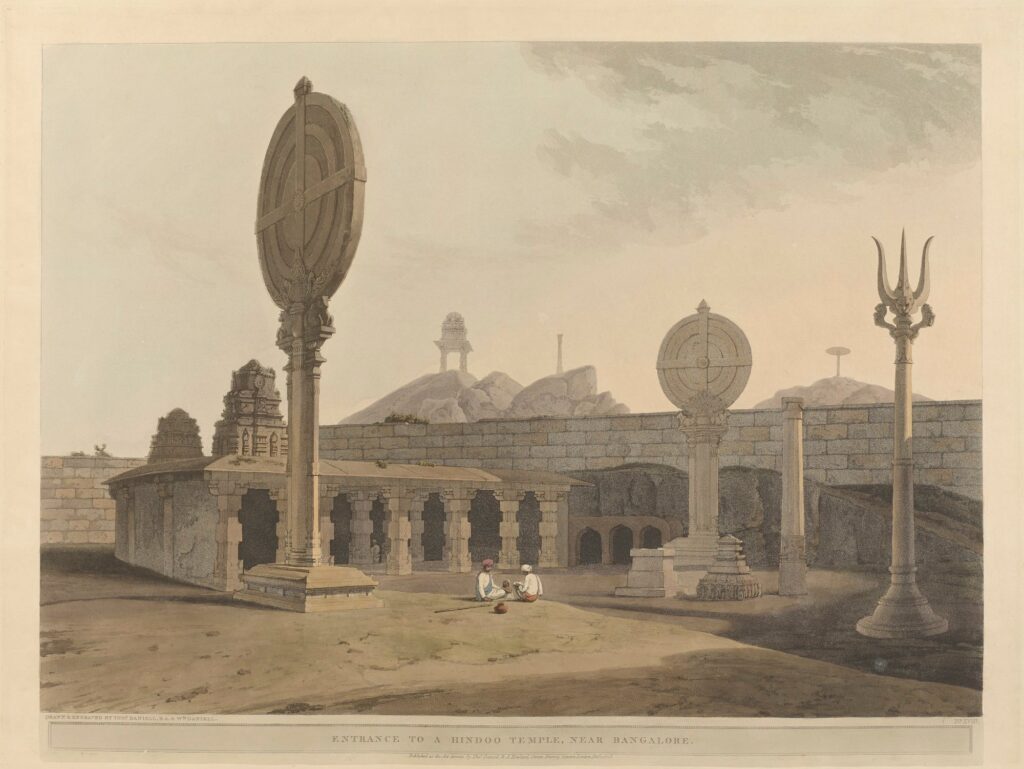
The passage of the setting sun through the cave of Gavi Gangadhareshwara temple on 14 January is very well-publicized. The recurrence of this event on yet another date is established from our observations supported by simple astronomical calculations. Observations extended to other seasons have shown that the two large discs in the courtyard are probably aligned to the summer solstice. The shadow of the bronze pillar coincides with the vertical marking on the disc, a fact which has gone unnoticed all these years. Thus it is a unique temple where markings of both solstices are incorporated. A detailed inspection of a painting of the temple, dated 1792, shows that the passage of the sunlight into the cave was also probably intended for marking the winter solstice. Subsequent constructions and renovations perhaps have modified it for 14 January (and 30 November). The summer solstice event is now totally forgotten.
The Gavi Gangadhareshwara temple in Bangalore is well known for a celestial event on 14 January every year, when the rays of the setting sun illuminate the idol of the deity inside a cave. The sun’s rays falling from the southwestern part of the temple pass through an arch and a couple of windows placed perpendicular to each other, and later through the horns of a Nandi (bull), to fall on the idol of the temple for about 15 min (between 4:55 and 5:15 pm).
We have observed the passage of shadows from 2005 through 2008. The architecture of the temple is discussed based on these observations. Two paintings of this temple and its vicinity by the famous British artist, Thomas Daniell during the mediaeval period throw more light on the possible purpose of the temple and the changes brought about in its architecture in the last two hundred years.
Annual and diurnal motion of the sun
The annual motion of the sun based on the definitions is simple, described by the change in the right ascension (RA—the east-west coordinate) and the declination (\delta—the north-south coordinate) throughout the year. The fact that the sun appears to move north-south along the ecliptic is expressed mathematically by the change of declination with longitude \lambda as
\[ \begin{align}\sin \delta= \sin \epsilon \times \sin \lambda,\end{align}\]where \delta is the declination, \epsilon the orientation of the rotation axis with respect to the plane of revolution (23.5^{\circ}) and \lambda the longitude of the sun.1 We have four important points in the orbit, equinoxes (when (\delta=0) and solstices (when \delta= \pm 23.5^{\circ}), corresponding to the duration of day and night being equal and extremes, respectively. A natural consequence of this is the fact that for all latitudes within +23.5 < \delta < -23.5, there are definitely two occasions when the sun will have the same declination. The direction of the sun’s rays at sunrise can be calculated using the simple relation
\[\begin{align}\cos A = \sin \delta \,/\, \cos \phi,\end{align}\]where A is the azimuth and \phi the latitude of the place. Thus, for Bangalore, there are two occasions in a year when the sun will have identical values of altitude and azimuth. Thus the phenomenon of 14 January, namely the sun’s rays passing through the windows to reach the idol in the cave, should recur on yet another date. This was observationally verified on 30 November and December 1. While the 14 January event is much publicized, the other one is not even known. The verification was done both in 2006 and 2007, and reported.2
The 14th of January corresponds to a harvest festival in the locality. However, there are many cave temples in and around Bangalore, where such alignments are not harboured. In this context, it is interesting to note that the majority of the temples in India are aligned to the cardinal points precisely. This has been verified from a survey of temples in and around Vijayanagar, Hampi.3 The temple under investigation is not aligned to the cardinal points. We further searched the documents in the Mythic Society and the Archeological Survey of India (ASI) about any previous work done on the astronomical significance. The historical significance gets highlighted in books aimed at tourism and the chart provided does not indicate the cardinal points.4 The architectural aspect has been discussed extensively. The chart provided does not indicate the cardinal points owing to the difficulty in deriving it inside the cave and no astronomical significance has been attributed.5 In the absence of any resources, we decided to investigate the origin of the temple with reference to its original alignment and the possibility of modification of its architecture.
Solstice events
Let us now consider the other features of the temple here. The main shrine is inside the cave. The terrace of the temple is accessible from either side; the western side has a smooth gradient, a natural feature of the hillock; the eastern side has steps carved on the hillock. The terrace of the temple provides a magnificent view of the sunset after the autumnal equinox in spite of the dense growth of the city. However, the view on the eastern side is obscured by the dense growth of trees in a park.

- Such discs have not been seen in any other temple.
- The cross-hair-like engraving appears on either side of the disc.
- They appear to be not aligned to the cardinal points.
It is important to note that the purpose of the discs has not been documented anywhere and is not known to the locals either.
We decided to monitor the shadows of the discs throughout the year. This was also essential to prepare a floor plan to identify the direction of orientation of the temple. We could not locate a floor plan in any record of the Mythic Society or the ASI. The terrace of the temple provides an ideal location to monitor the annual changes. The visibility of the sun during the mornings is hampered by trees towards the east. The situation is only slightly better in the western direction. The movement of shadows during 2006–08 helped us to prepare a plan of the temple.
We noticed that the discs too have a significant feature incorporated in them. The shadow of the western disc gradually moved towards the eastern disc. However, if the orientation of the entrance was exactly west, the shadow of the western disc would have touched the eastern disc on days of equinoxes at sunset. The shadow remained quite far from the eastern disc on equinox days, but gradually moved towards it during June. This showed that the orientation of the entrance to the temple is not to the east as is common in many other temples. The shadow moved towards the eastern disc and almost made it during the summer solstice. Since the view of the horizon is blocked by the trees, tracking could not be continued till sunset. Marking the position of the shadow till the last possible minute, we calculated further movement using the following formulae6
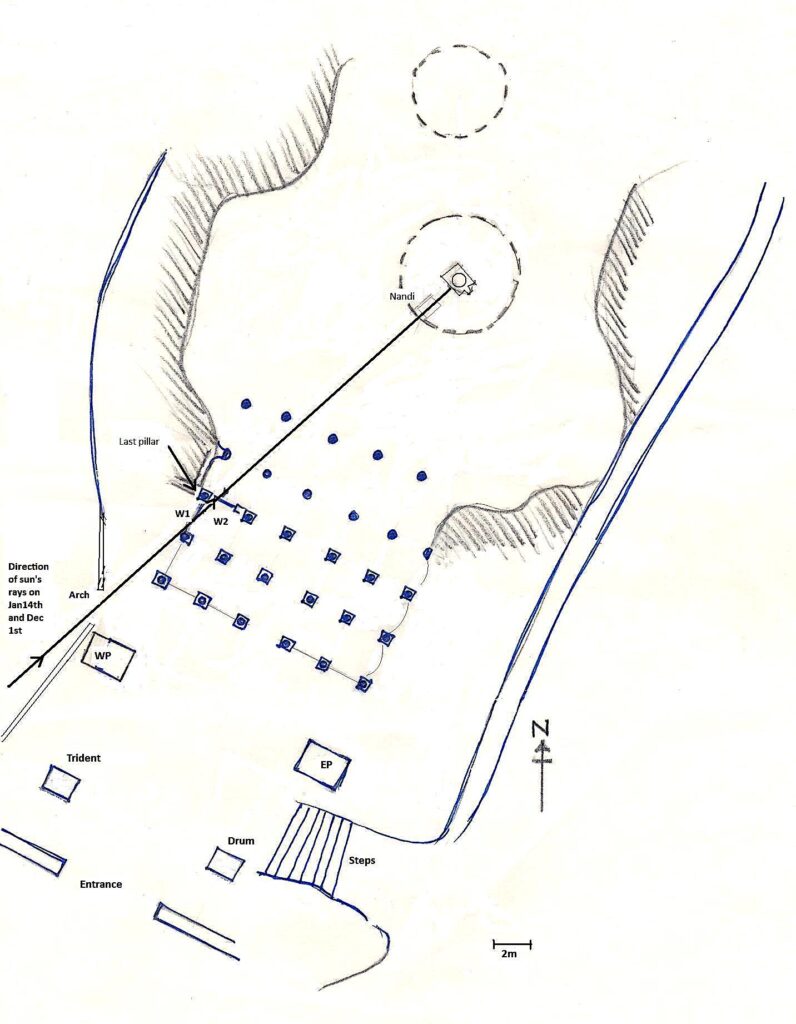
dA &= \{\cot z \cos A \cos \phi – \sin \phi\}dH\end{align}\]where dz is the change in the zenith distance, dA the change in azimuth and dH the change in the hour angle. The shadow never crossed the eastern disc but retreated after June, giving us a clue that the alignment is to the day of the summer solstice. Thus now we are ready to draw up the floor plan.
An approximate sketch of the floor plan as deduced from our observations appears in Figure 1. The orientation is clearly along a line quite different from the conventional NS or EW lines. The two large discs are aligned to the point of sunset on the summer solstice. Figure 2 explains this geometry of the solstices. Observations were carried out around the summer solstice, as listed in Table 1. The position of the shadow was noted (photographed whenever it was possible).
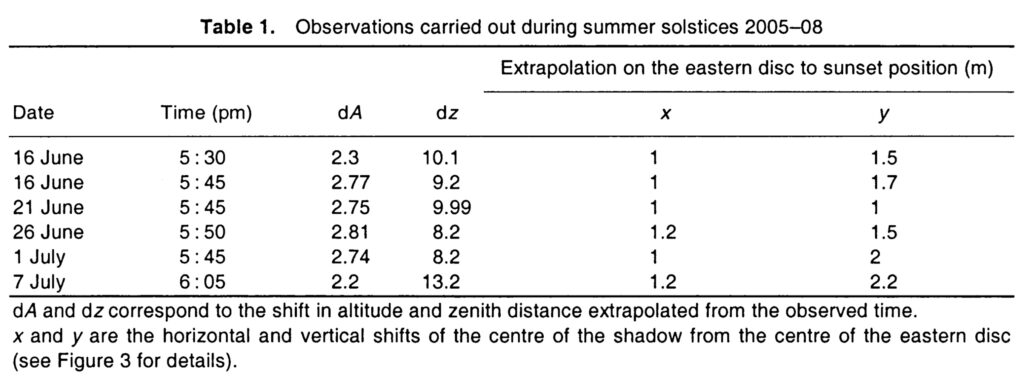

Observations were carried out on all days, whenever the weather permitted. Table 1 lists the calculated values of dA and dz along with the graphically obtained values of x and y. Notice that the values of dx and dy are less than 2m. This is proof of the deduction about the alignment of the summer solstice, since the diameter of the disc is about 2m. These estimates are likely to have large errors owing to the fact that the shadow on the photograph is not in the same plane as the eastern disc, but is on the rock which is about 3m behind the disc.
A closer look at Figure 4 shows the shadow of the `Dhwajasthambha’ on the eastern disc about 40 minutes before sunset. In fact, it exactly coincided with the vertical line of the disc. Its further passage to the edge, making way for the shadow of the other disc could not be verified owing to the dimming of sunlight and the thick growth of trees closer to the horizon. In the absence of verification at the exact sunset of the summer solstice, it may only be conjectured that the discs were used to fix the day of solstice precisely. Therefore, we find that the Gavi Gangadhareshwara is unique because of the following reasons:
- Alignment of the arch, windows and the Nandi to the sun’s rays on 14 January and also 30 November and/or 1 December.7
- Alignment of the two large discs to the summer solstice sunset, a fact which was hitherto unknown.
Let us study the objective of this alignment in the construction of the temple as deduced from a different source.
Deductions from paintings of Daniell
In this context, two paintings by the brothers Thomas and William Daniell provided valuable evidence.8 The paintings depict the scene as in 1792, from two different angles. The first painting shows the region adjacent to the temple to the east; it is clear that the region was barren, devoid of any vegetation, providing clear visibility to the horizon.
 |
 |
The second painting depicting the temple itself provides some more clues about the architecture. This painting, dated 1 May 1792, may be compared with the photograph from 2007. It is clear that the temple has undergone a facelift and in the process, new walls and enclosures have been constructed. This prevents one from getting an identical view today. It may also be noted that the `Dhwajasthambha’, a bronze pillar, is a later addition. As we have noted earlier, the shadow of this falls on the vertical mark on the disc. Whether it was intentional or a coincidence (since there is no awareness or record of the introduction of this idea) is debatable, because it is an addition in the last two hundred years.
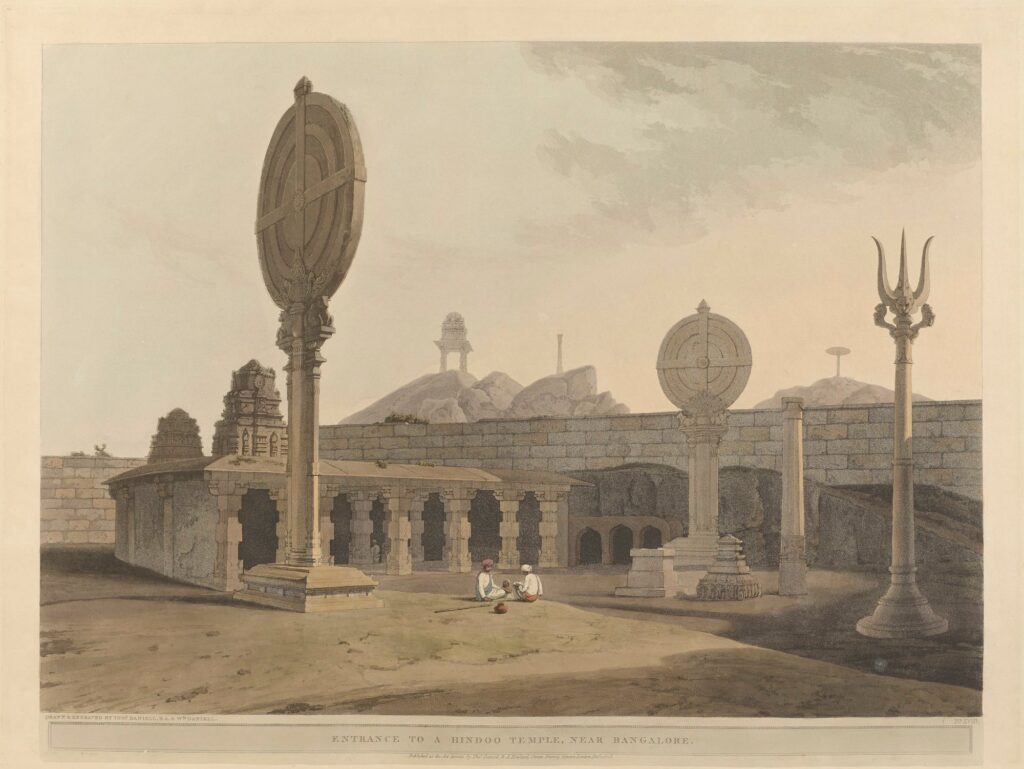 |
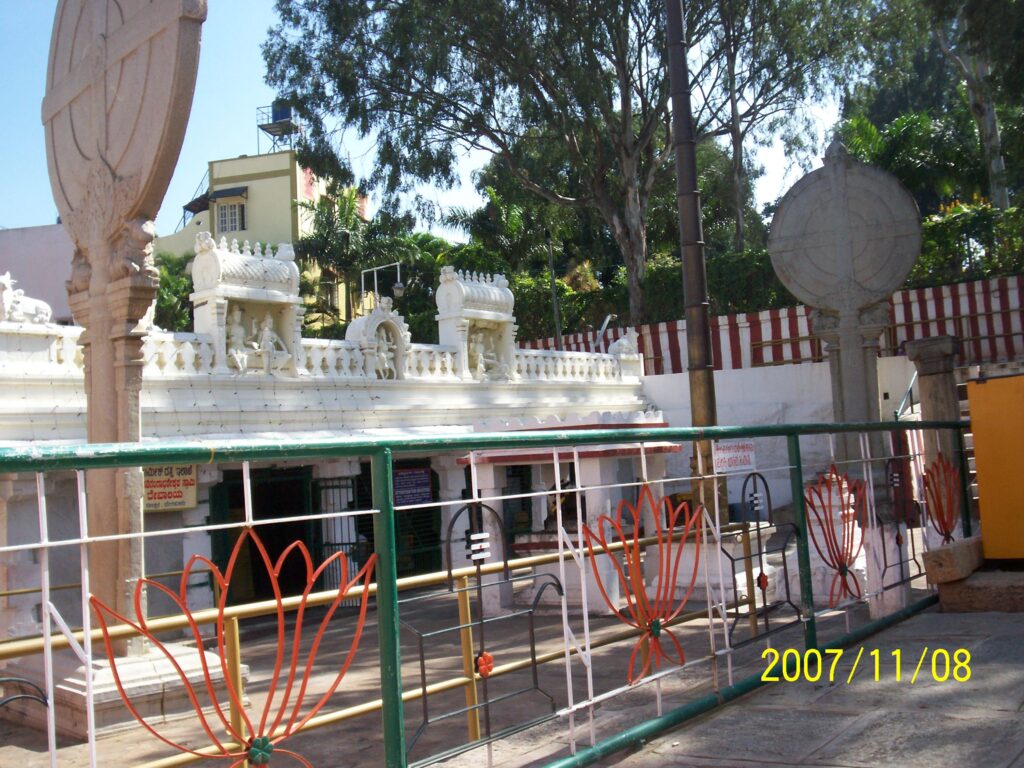 |
The comparison also shows that the approach to the terrace of the temple (perhaps for monitoring the shadows of the discs) has been retained and the gentle slope along the rock has now steps cut along. The two `gopuras’ corresponding to the locations of the deities underneath have remained intact. The two are aligned along the north-south direction. The intriguing figures on this `Śikhara’ appear to have remained undisturbed, a fact of interest to historians of the cultural and traditional heritage of this area. This is attributed to the Nath cult (S.K. Aruni, personal communication).
The footnote accompanying the painting mentions9 that it was `deserted’. Perhaps it was empty too!
Another important difference is that three arch-like structures adjacent to the entrance are now enclosed inside the temple. This must have been done after constructing a new set of pillars and putting stone slabs for the ceiling. This can be verified from the inside. These pillars have been marked with a different symbol in Figure 1. Therefore, we may deduce that this `Mantapa’-like structure, arch and the windows through which the light enters the cave on 14 January (as well as 30 November–1 December) are definitely a later addition.
This brings us to the question of the orientation during and prior to 1792. Figure 1 shows the pillars which were probably constructed later, with a different symbol. The `last pillar’ in Figure 1 would have been then the edge of the cave and it would provide another 2.5^{\circ} for the day of the winter solstice sunbeam to enter the cave. Therefore, we may conclude that
- the edge of the cave allowed light to enter only on winter solstice and not 14 January, and
- the mantapa and its ceiling are a later construction and not part of the original cave.
We deduce that sometime after 1792, the cave was perhaps encompassed by the mantapa. This had walls and windows designed to ensure that the light reaches the cave on 14 January. Quite obviously, this has happened in an era when the solar calendar months were already in use. It is quite possible that the significance of 14 January (the sun’s entry into Capricorn or `Makara’) was incorporated into the construction of windows. For a long time, there has been a wrong notion that `Makara sankrama’ is the same as the winter solstice.10 Similarly, it is likely that the `Dhwajasthambha’ was installed to mark the entry of the sun into Cancer or `Kataka’.
Thus it turns out that this was a unique way of marking the days of the solstice which were important for calendar makers. The cross-hair-like marks also corroborate this idea. The unusual discs of the temple attracted the Daniell brothers and the painting was later chosen as a special one and selected by Thomas Hope as representative of the various aspects of Indian architecture. It would therefore be interesting to look for other records associated with the temple prior to 1792.
The alignment of the discs for the sunset of 22 June will also exactly match with the alignment of the sunrise of 22 December. This is directly deduced from equations (1) and (2) and shown in Figure 2. The value of \delta changes from +23.5 to -23.5^{\circ}. The paintings also provide us with another clue here. Looking at the barren landscape it appears that the same discs were probably used for marking the sunrise of the winter solstice too. As mentioned above, it can also be conjectured that on 22 December the shadow of the eastern disc exactly covers the western disc at sunrise.
The 22 June alignment can be verified with some difficulty now; but not for 22 December. The vast growth of tall trees prevents a view of the horizon towards the east.
Marking of the solstices was an important objective of the astronomers of yesteryears. It may be noted that the cave at Udayagiri also has the solstice as an important event.11
The ideal dates for observing the Gavi Gangadhareshwara temple are as follows: one extending from 26 November to 2 December, the second from 13 to 16 January. Generally, these dates have clear skies. The summer solstice event can be watched for a still longer duration from 16 to 26 June. Although the weather is usually not favourable for the sunset event, the shadow of the Dhwajasthambha is observable.\blacksquare

Footnotes
- Smart, W. M., Text Book on Astronomy, Cambridge University Press, 1962. ↩
- Jayanth Vyasanakere, P. and Sudeesh, K., Resonance, 2008, 13, 768. ↩
- New light on Hampi, Recent research in Vijayanagara, (eds. Fritz, J.M. and Mitchell, G.), MARG, 2001. ↩
- Issar, T.P., The City Beautiful, Bangalore Urban Art Commission, 1998, p.140. ↩
- Aruni, S.K., Yalahanka nāḍa prabhugaḷa vāstuśilpa mattu śilpakale, 2007, Bangalore University (in Kannaḍa). ↩
- Sharma, S.K., Gupta, R.K. and Dhirendra Kumar, Spherical Astronomy, Krishna Prakashana Mandir, Meerut, 1987-88, p.105. ↩
- Jayanth Vyasanakere, P. and Sudeesh, K., Resonance, 2008, 13, 768. ↩
- Archer, M., Early Views of India—The Picturesque Journeys of Thomas and William Daniell 1786–1794, Thames and Hudson Ltd., London, 1980. ↩
- The accompanying text reads “The entrance of the temple has a very striking effect from the size and singularity of the mythological structure wrought in stone, … trident of Mahadeva and the chakra of Vishnoo supported perpendicularly. … The passage leading to the interior which is partly evacuated, is completely choked up with large stones so as to be inaccessible. This place, having now no establishment for religious duty, is accordingly deserted”. ↩
- Shylaja, B.S., Current Science, 2007, 92, 846. ↩
- Balasubramaniam, R. and Dass, M.L., Current Science, 2004, 86, 1134. ↩
